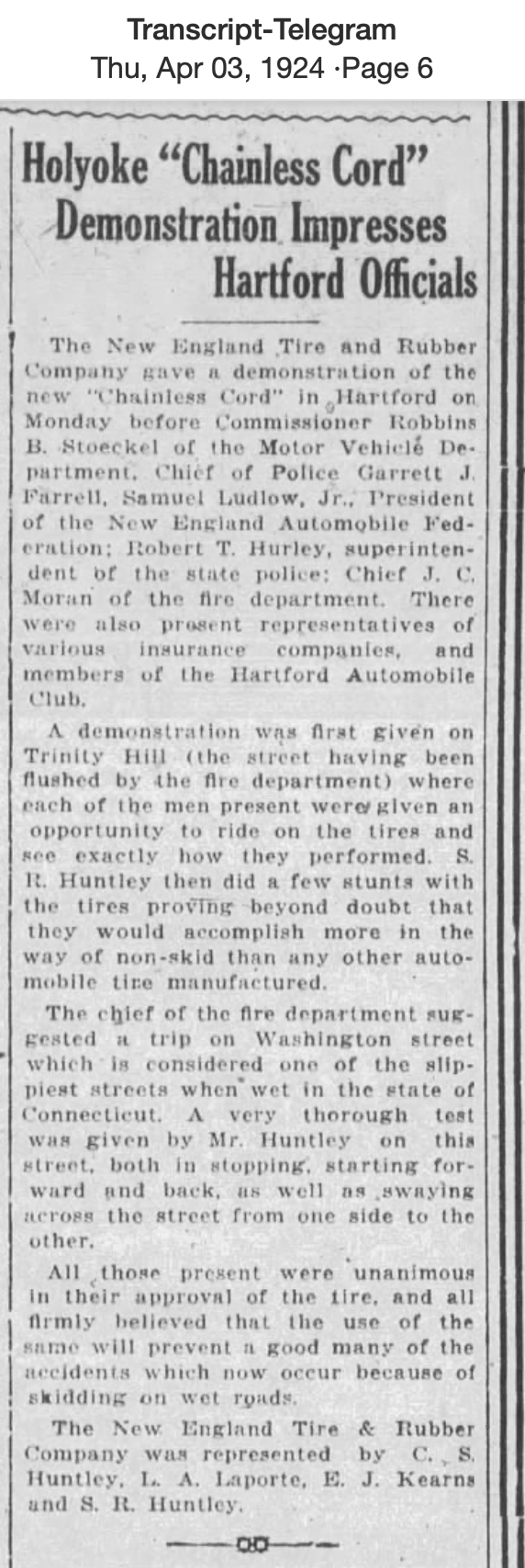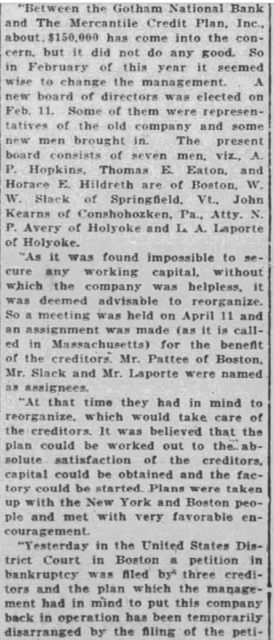When thinking of Holyoke's industrial history into the 1920s, significant manufacturing that comes to mind includes papermaking and paper products, thread companies, silk, machinery, and garments. Tire production is usually not on the list; however, that's the subject of today's post.
In May 1920, a newly formed corporation, the New England Tire and Rubber Company, announced a $3 million dollar stock offering for those interested in investing in a tire and tube factory.
The original plan was to build the plant in the Willimansett section of Chicopee, MA. The founders, former executives of Fisk Rubber Co. in Chicopee, recognized a substantial labor pool of skilled tire makers who worked at that plant and resided in Holyoke. They hoped to draw these employees to a location closer to their homes.
The effort to build a new factory in Willimansett was unsuccessful, so the principals turned to Holyoke. Land was secured from Holyoke Water Power Company at what later became 728 Main Street. Until construction was completed, the company office was temporarily situated at 285 High Street.
The stock offering quickly raised the necessary capital and groundbreaking occurred in July, 1920. The plant would be built by the Casper Ranger Construction Company with a completion timeline of five months. It would encompass three stories and 60,000 square feet of space. Room was left on the land to expand with three additional buildings similar to the original. A rail spur was envisioned to the rear of the property and the river's use to transport goods.
The plant could produce 1,000 tires and 1,500 inner tubes daily. At its inception, executives planned to produce 500 tires daily and ship the Holyoke Cord tires as early as February 1921.
Its durability and long life distinguished the Holyoke Cord from its competitors. Anecdotal reports indicated the tires could last three times the competition.
Although the building was roofed and enclosed on February 1, 1921, delays in receiving machinery and parts delayed the plant's dedication until September 15, 1921. An economic downturn in the country was indicated as a cause. The company was producing 100 tires daily on a contract with another manufacturer.
By this time, New England Tire and Rubber Co. and Holyoke Gas & Electric had entered into a contract to supply 600 horsepower electricity. A well-drilling led to an underground spring supplying 500 gallons of pure water per minute.
The plant began operating in late 1921, more than a year from the planned date.
In 1922, Holyoke Water Power granted the Holyoke-Westfield Railroad a right to build a spur from the Chemical Paper Company to the old Ferry Road.
In 1924, the company introduced a second tire called the Chainless Cord. This "non-skid" tire functioned well in rain, ice, and snow. It was well received and garnered accolades from its presentations along the Atlantic Seaboard.
The company closed during the final two weeks of 1924.
A meeting of stockholders was held in January 1925. The new company president, who was elected on October 1, 1924, indicated that the Holyoke Cord tire could not compete with the larger national producers and should be discontinued. The company received a patent on the Chainless Cord and that was the company's future. The cooperation of the stockholders was needed.
Another shareholder advised that the company was undercapitalized from its inception and that a $100,000 working account be established to continue operations.
The company's fortunes changed further in April 1925, when creditors sought to collect on the tire company's debts. On April 11, 1925, the Board of Directors voted to enter an assignment for the benefit of creditors to preserve the company's assets for creditors and shareholders. This would be a first step to reorganizing to save the business, as lenders had shut off its working capital.
Eight days later, on April 19, 1925, three major creditors united and compelled the company into bankruptcy. Around this time, the business ceased operating. Attempts to reorganize during bankruptcy by raising money had been unsuccessful.
In 1926, the building and all the equipment were sold to the Mercantile Credit Plan Company of Boston, a major company bondholder. In 1927, Reynolds Manufacturing Co. purchased the building in an expansion move from its former location at North Summer and Lyman St.
Source of news articles: Newspapers.com (paid subscription): Citations: Holyoke (Massachusetts) Transcript-Telegram; publication dates are shown.












































No comments:
Post a Comment